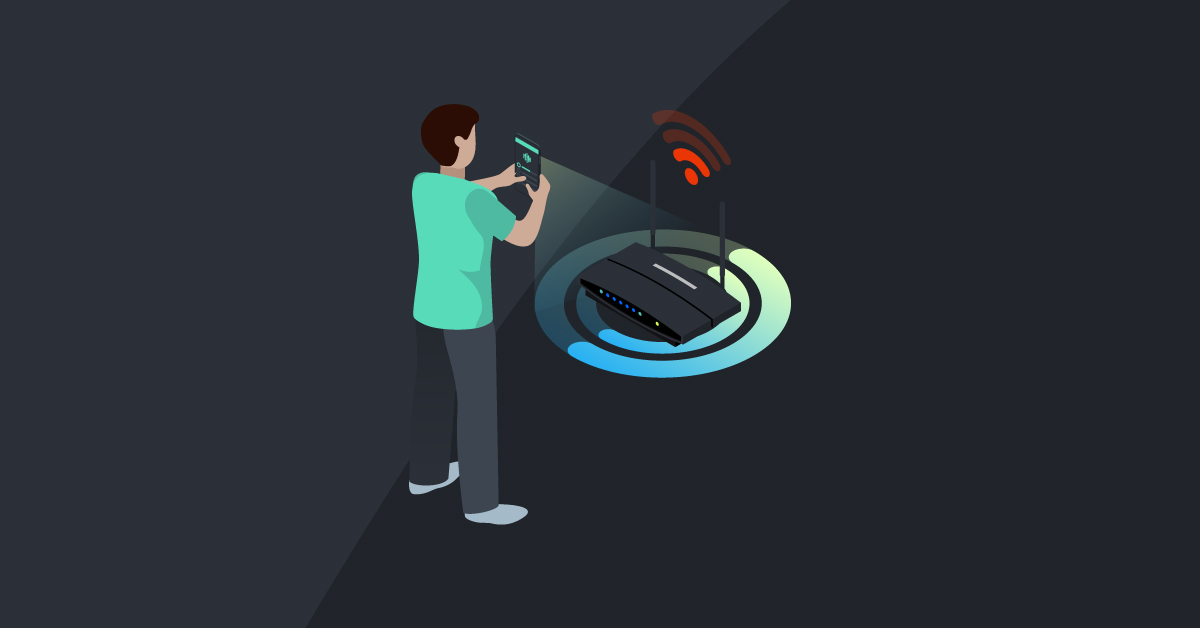How to provide the best in-home customer experiences as a service provider
The customer experience is one of the most important key performance indicators for service providers.
While a subscriber’s in-home environment isn’t traditionally considered a service provider’s responsibility, shifting subscriber expectations illustrates how important it is to support and solve issues within the home. This shift is forcing service providers to rethink this tradition—and consider how they can manage and support the in-home environment. This allows service providers to build strong relationships with their subscriber base, grow revenue, and retain happy subscribers.
As you read through this guide, you’ll learn about the importance of the in-home experience, why service providers struggle to deliver great in-home experiences, and what the must-haves are for better subscriber relations.
| 🛎️ | 54% of today’s customers say they have higher expectations for customer service than they did a year ago (Microsoft) |
| 🏃 | 66% of churn is preventable if companies resolve issues the first time (thinkJar) |
The importance of the in-home experience
For a service provider, a subscriber’s in-home experience is a big deal. It’s everything that happens with your services within a subscriber’s home—far from the helpful hands of support agents and technicians. When there’s a problem, it’s often an issue with the subscriber’s home setup, device placement, cabling, or something completely unexpected.
But to the subscriber, every single issue they encounter with their internet service is the result of your company and gets attributed to the customer experience your company delivers. These experiences can significantly impact your company, especially your overall reputation and revenue.
To understand these impacts better, let’s explore how in-home experience affects your business and your bottom line.
🔀 |
58% of American consumers will switch companies because of poor customer service (Microsoft) |
🤔 |
50% of customers will consider leaving for a competitor after one bad experience (Zendesk) |
1. It defines how—and how effectively—you attract new subscribers
The art of attracting new subscribers has changed dramatically over the years. Where once it was enough to have the best prices or the fastest speeds, modern consumers expect more. They want to know your company personally: they’ll look at online reviews, speak to their peers, and examine every potential resource they can find on your service provider’s customer experience.
2. It builds a foundation for you to expand current accounts
When a subscriber calls in to complain about slow WiFi, and you discover they have an older router or even a dead spot in the router’s signal, the solution for these problems presents an excellent opportunity to upsell subscribers to mesh pods or managed WiFi. However, for this to work, the subscriber must trust you and the experience you deliver.
3. It provides the key to retaining your existing subscriber base
When a subscriber calls in, they expect to be able to connect with an agent quickly and have their issue resolved with as little work on their end as possible. They also expect the problem to be solved the first time. Without that experience, even one poor customer experience can lead to a subscriber leaving for a competitor. But this is preventable if companies resolve issues the first time they happen.
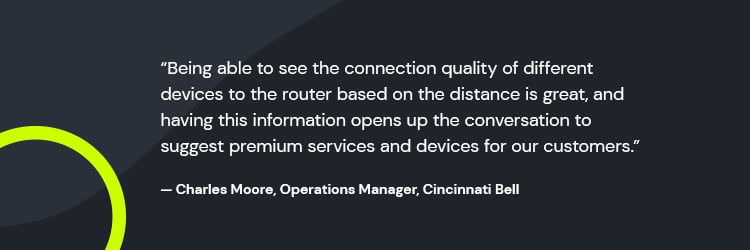
Why service providers struggle to deliver great in-home experiences
Too often, the experience subscribers receive from service providers declines because of in-home variables. After all, every home network is unique. Subscribers usually understand that; they won’t cancel their service with you or leave a negative review the first time their Netflix gets stuck buffering. They’ll contact your support team instead.
This is exactly where the customer experience problem starts. Supporting the in-home experience is notoriously difficult for service providers—often resulting in long handle times, repeat calls, and unnecessary tech visits. These are all things that diminish the customer experience.
So what are the in-home variables that cause this problem? Let’s find out.
📞 |
66% of customers are most frustrated by waiting on hold (Hubspot) |
⌛ |
60% of customers feel that long holds and wait times are the most frustrating parts of a service experience (Zendesk) |
1. Subscribers don’t know or understand their networks
As far as most subscribers are concerned, anything that prevents a device from loading Netflix is a problem that their service providers needs to fix. When a subscriber is convinced that their problem is happening because of the services you provide, agents need the tools to help subscribers understand the differences and see where the root of the problem is to correct it.
2. Agents have limited visibility into in-home issues
Without proper insight into the home network, agents have to resort to playing 20 Questions with the subscriber, but depending on the technical aptitude of both the agent and the subscriber, there’s a good chance a miscommunication will happen. That leads to an incorrect resolution that doesn’t solve the problem on the first call, which can turn into repeat calls and, more than likely, costly truck rolls.
3. Subscribers don’t get the same experience from every agent
The experience subscribers receive depends on the agent’s technical aptitude and expertise, which can vary dramatically. Training and ongoing education can certainly help minimize the impact of this variable. Still, there will always be agents who struggle to answer questions, either because they’re unfamiliar with the technicalities of a certain issue or because they’re not sure how to explain it properly.
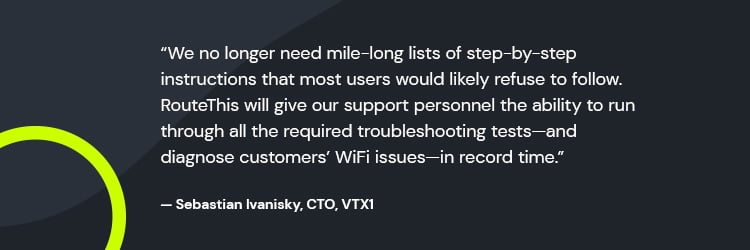
Must-haves for a better in-home experience
Creating better in-home experiences for subscribers starts with the variables that contribute to poor experiences. If you can solve those variables, you can actively improve the overall experience your subscribers receive, opening up revenue opportunities for your business.
But how do you solve for those variables?
📈 |
Businesses can grow revenues between 4% and 8% above their market when prioritizing better customer service experiences |
💸 |
70% of U.S. customers say they'll spend more money with a company with better service (Help Scout) |
1. Visibility and automation
When agents need to go back and forth with subscribers to gather technical information, the entire process quickly becomes time-consuming and error-prone—not to mention frustrating. By providing proper visibility and automating steps to resolution, agents can resolve issues accurately, prevent repeat calls and churn, reduce the time subscribers need to spend on the phone, and leave a lasting positive impression on that subscriber.
RouteThis helps eliminate the pains of manual troubleshooting by giving agents complete visibility into the home network and automating key process steps. Its automatic scans use the subscriber’s smartphone to analyze the network and identify any issues, eliminating the back-and-forth approach to troubleshooting. It can even suggest potential solutions before the scan is complete!
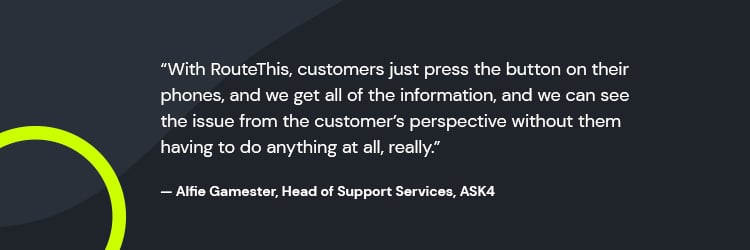
2. Subscriber education
Subscribers don’t always understand how WiFi works, let alone the ins and outs of their network—and agents don’t necessarily have the tools to clear things up for them. To build trust and improve experiences, agents need tools to help keep subscribers involved throughout the process.
RouteThis provides the tools for agents to educate subscribers with key information about their network, including how the agent’s actions will affect their network’s performance and how the subscriber can set up their network to avoid similar problems in the future.
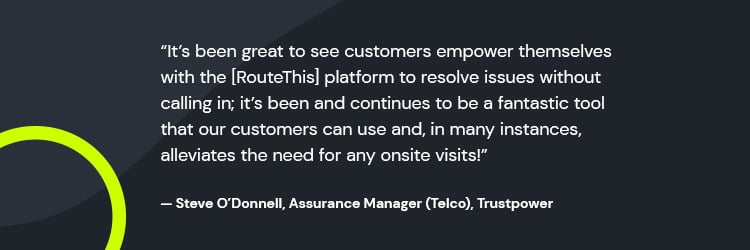
3. Consolidated tools and dashboards
On average, service provider support agents flip between five to eight tools to resolve one internet performance issue. This can affect average handling times, accuracy, and first contact resolution rates. That’s not to mention the cost it adds, which can cost the average support team about $5,000 per agent per year.
With RouteThis, all those tools combine into one handy dashboard to cut down flipping between different windows. It can also help agents choose the right tool at the right time, reducing the risk of inaccuracy and saving time on the call.
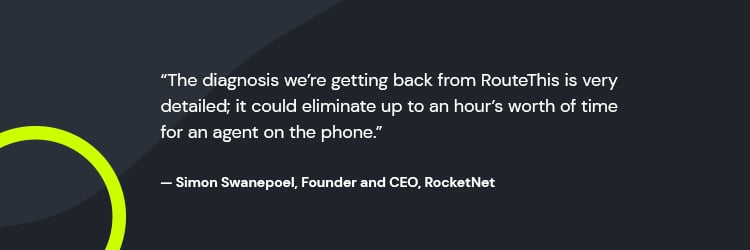
4. Simple and accessible tools
Too often, broadband support tools are designed for agents with technical aptitude and can be difficult for less technical agents to use. This is where the inconsistent experiences that frustrate subscribers start.
With RouteThis, you can provide agents with a simple, easy-to-use tool that ensures every agent can deliver the same level of technical support, improving the experience your subscribers have. It provides guidance, tips and tricks, and talking points that help agents handle any issue, no matter their level of expertise.
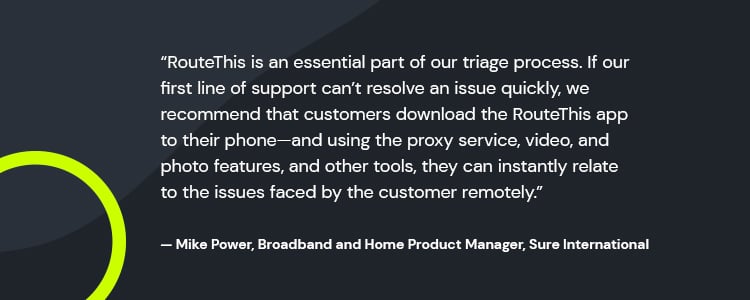
5. Resolution-first behavior
In any tech support organization, only about 15–25% of the entire agent pool is what the company would consider top-performing agents. These are typically the ones who create the strongest positive experiences for subscribers through expertise and manner and are the most likely to contribute to revenue opportunities.
With RouteThis, you can encourage and develop the right call behaviors, conversations, and actions to help your entire service provider support team handle calls with the same top-performer approach.
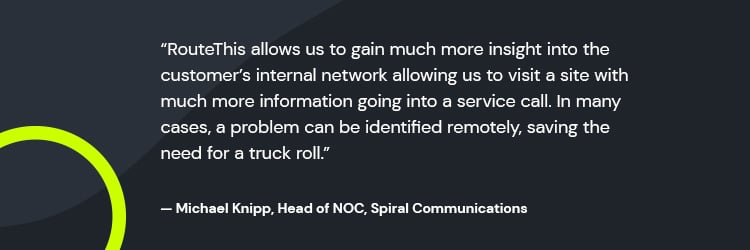
Switch up your in-home customer experience
As a service provider, the last thing you want is for your brand to be overlooked or known for bad customer service provider experiences. Even if every other part of the customer experience surprises and delights your subscribers, they’ll first remember the poor support experience, especially for in-home WiFi connectivity issues.
While most service providers aren’t focused on or equipped to handle the in-home experience, now is your time to meet your subscribers’ high expectations.
RouteThis can help you deliver the experience subscribers expect so you can continue to drive growth, increase revenue, and, most importantly, retain a happy subscriber base.

